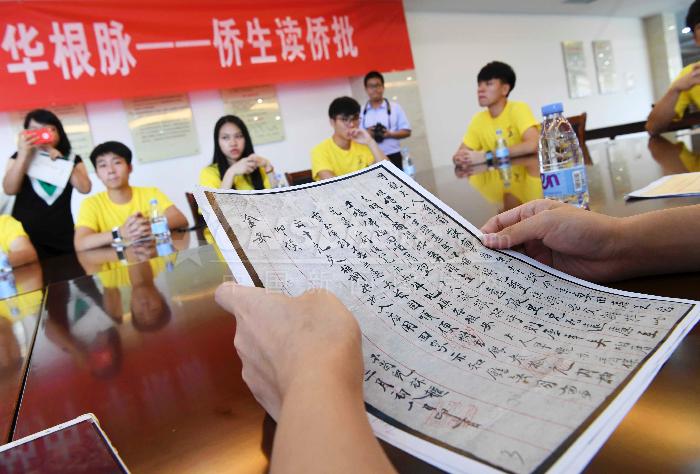Documentary heritage constitutes evidence of overseas Chinese history

Overseas Chinese students learn about Teochew letters at a reading event.
In the word qiaopi, qiao means Chinese emigrants overseas while pi indicates letters in Fujian dialect. During its thriving period, remittances were always accompanied by a letter from Chinese living overseas to update their families back home about their lives. The exact time when Teochew letters first appeared in history remains unknown due to the absence of empirical material. The Museum of Overseas Remittance Mail Relics situated in Shantou, Guangdong Province, is the country’s first museum that preserves Teochew letters. Its collection includes the earliest known example of a Teochew letter, which dates back to 1881. However, such correspondences would have appeared at the time when Chinese people started to go abroad. Fellow workers or water travelers, who shuttled frequently between Teochew region and Southeast Asia for business, collected money, letters and oral messages from Chinese emigrants and sent them back to their homes.
Overseas Chinese are called Tang people in East Asia and some Western countries, leading to the speculation that considerable numbers of Chinese people went abroad during the Tang Dynasty, a high time of China’s exchanges with the outside world. Also, “Teowchew residents’ migration to foreign countries can be traced back to as early as the Tang and Song dynasties,” according to the local annals. There was a possibility for many Chinese seek a living overseas due to foreign exchanges, natural disasters and war troubles. In this light, the advent of water travelers should have taken place in this period before the business became a service industry. They were supposed to meet the demand for communication between overseas Chinese and their families.
Remittance and letters are sent together. Overseas Teochews remitted part or most of their income to families and wrote letters to uinform their updates and to ask about their loved ones. Teochew letters created a comprehensive service sector that included commercial trade, financial currency, political economy as well as information about their wellbeing, moral codes and local customs.
All generations of overseas Chinese never went abroad to expand their territory. In contrast, most of them were forced to seek livelihood in a totally strange environment, overcoming all kinds of difficulties. As the breadwinners of the families, many emigrants were concerned about their parents, spouses and children being able to live a peaceful life without starvation. Meanwhile, people at home prayed for their safe return at shrines to Buddha. Teochew letters served as a way to ease these mutual concerns.
In traditional Chinese moral codes, people should never forget roots or their families. The successful overseas Chinese still sent most of their incomes to restore ancestral houses, enlarge homes and educate relatives’ offspring even though they may have struggled to achieve this fortune. Later, the money was even used to help out the poor, fight natural disasters and finance the war of resistance against Japanese aggression. Their financial support was a decisive factor driving the economy of Teochew region. According to local annals, 40 to 50 percent of Teochew people relied on the money delivered in Teochew letters to get by while most big enterprises and infrastructure construction were funded in part by the investments of overseas Chinese. Each year, Teochew’s spending greatly exceeded its revenue, and overseas Chinese were undoubtedly largely responsible for this sustained prosperity. As a result, all sectors suffered and many died from starvation when the qiaopi industry was blocked during the war of resistance against Japanese aggression.
The need for delivery gave birth to a qiaopi service industry. In that time, water travelers probably would first use the sender’s money to purchase things in the foreign countries and sell them in China for local currencies. In this way, the delivery itself involves foreign commercial trade. The delivery service produced professional water travelers as the number of overseas Chinese kept rising.
The water travelers were acquainted with circumstances of both regions, having abundant experience in transport shipping. Therefore, they often would take people during their trips, including relatives of overseas Chinese or laborers who sought to make a living abroad. Water travelers ran businesses with the help of some stores and charged locals delivery fees within a certain area. They would go deep into mines, enterprises, plantations and farms to collect remittance and letters, or they posted advertisings at a fixed location for trade. The round-trip trade and delivery, despite its high risk, generated them a considerable income. Therefore, large amounts of people engaged in this field and they were popular for connecting overseas Chinese and their relatives.
Water travelers could no longer meet the needs of overseas Chinese due to the surging number of people moving abroad after the second half of the 19th century. Historical material recorded that 20,824 people departed overseas from Shantou port in 1869 and the figure continued to grow, hitting 100,000 each year at the dawn of the 20th century. In this context, some specialized agencies came into being and golden age of the industry arrived at the turn of the century.
The industry was temporarily suspended during the war of resistance against Japanese aggression during which many people in the Teochew region suffered hardships. Later, it resumed part of the business as staff of Teochew letter agencies changed the delivery route so that Teochew letters were transported from Dongxing, a town in China-Vietnam border in northern Guangdong to the province’s northern county Xingning, ultimately arriving in the Teochew region. When the industry fully recovered after China’s victory in the war, overseas Chinese cried tears of joy. Afterward, the industry continued to operate until it was merged into the banking industry in the 1970s.
(edited by MA YUHONG)
